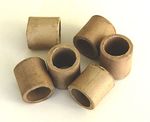Raschig ring: Difference between revisions
Jump to navigation
Jump to search
Uncle Jesse (talk | contribs) (Creating a wanted page) |
Uncle Jesse (talk | contribs) No edit summary |
||
| Line 1: | Line 1: | ||
Pieces of tube, approximately equal in length and diameter, used in large numbers as a packed bed within [column|columns]] for [[distillation]] and other chemical engineering processes. They are usually ceramic or metal and provide a large surface area within the volume of the column for interaction between liquid and gas vapors. Raschig rings are named after their inventor, the German chemist Friedrich Raschig. | Pieces of tube, approximately equal in length and diameter, used in large numbers as a packed bed within [[column|columns]] for [[distillation]] and other chemical engineering processes. They are usually ceramic or metal and provide a large surface area within the volume of the column for interaction between liquid and gas vapors. Raschig rings are named after their inventor, the German chemist Friedrich Raschig. | ||
[[Image:Raschig_rings.jpg|thumb|150px|left|Raschig rings]] | [[Image:Raschig_rings.jpg|thumb|150px|left|Raschig rings]] | ||
Revision as of 14:37, 4 September 2017
Pieces of tube, approximately equal in length and diameter, used in large numbers as a packed bed within columns for distillation and other chemical engineering processes. They are usually ceramic or metal and provide a large surface area within the volume of the column for interaction between liquid and gas vapors. Raschig rings are named after their inventor, the German chemist Friedrich Raschig.
